Polish Kanapki
I really like Polish food. I suppose in part it is because I like all those things that are stereotypically associated with Polish cuisine–carb-laden dumplings and fatty meats, smoked sausages and rich stews. But while I haven’t delved as thoroughly into their cuisine as I’d like–I may be able to tell a pierogi from a pyzy but when it comes to picking out a sausage I still have to point and say “that one”–it doesn’t take a deep dive to see that there’s much more to Polish cuisine than great lumps of fat and carbs. The richness we often associate with Polish cuisine is more than balanced by the sour flavors of fermented vegetables and sour soups and the light flavors of fresh salads of cucumbers and carrots. There are apples and cabbages, beetroots and horseradish, and the mushrooms! So many mushrooms!
And for someone who likes Polish cuisine and wants to try a lot of it, there are few better places to live than the Chicago area. I used to hear it said that Chicago had a higher population of Polish people than any other city besides Warsaw. According to Wikipedia that is not now the case–New York City has more Polish-Americans, though the concentration is higher in Chicago. But look at what a quick Google Maps search turns up for Polish Delis.
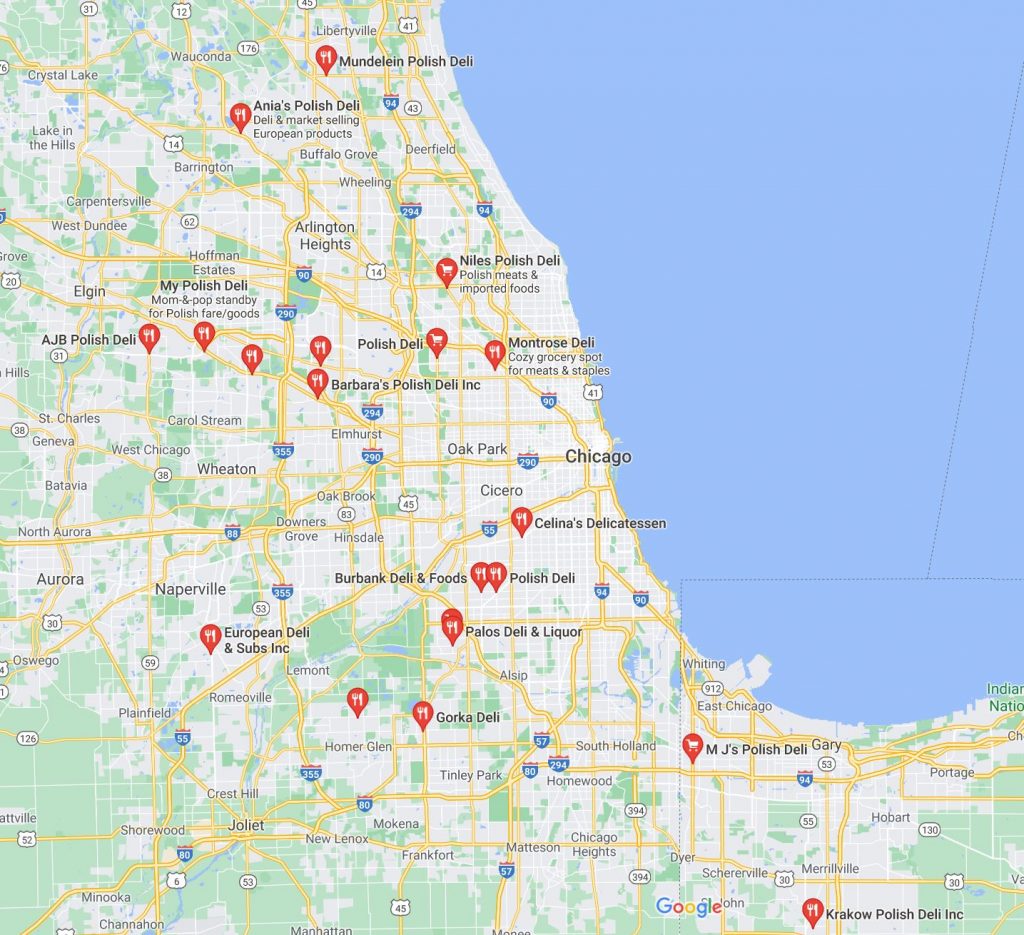
This doesn’t tell the complete story either–I can see right off the bat that it doesn’t include Kasia’s Deli, where we tried an interesting sandwich in 2015, or Andy’s Deli, where Mindy and I used to shop somewhat regularly when we still lived on the North side, or Gene’s Sausage Shop, which was once the strictly German Delicatessen Meyer but was reopened as a “European” deli by a Polish-American family after Meyer closed well over a decade ago, or Kurowski’s, or plenty of other local Polish spots. But it does do a decent job of showing the concentration of Polish-Americans in Chicago, and the trajectories–to the northwest, and to the southwest, well-established patterns of White Flight traveled by other European immigrant communities before them.
I live not far from that southwestern corridor, and have a few Polish delis I frequent. Having a Polish sandwich come up on our List is always a welcome excuse to visit them. Kanapka (or kanapki in its plural form) is the first of three sandwiches we’ll be covering this month. The word derives from the French canapé, but while canapé describes a single-bite, decorative morsel, kanapki are open-faced sandwiches along the lines of some that we’ve covered before–Butterbrot, Smørrebrød, Obložené chlebíčky. It is my understanding that while Kanapki can be more elaborate like the latter two, they tend more toward the simplicity of the former–bread, butter, a meat topping or prepared spread and a vegetable garnish.
To learn more about the sandwiches, I stopped by some of my local Polish delis to see what they could tell me. First was Gorka Deli in Orland Park.





Gorka is in a lesser-traveled strip mall somewhere along the stretch of LaGrange Rd that is nothing but strip malls, somewhere between the Trader Joe’s and the Whole Foods. (I navigate by food) It’s a little sleepier than some of my other regular Polish delis but on the particular weekend I visited, ahead of Poland’s Constitution Day, the aisles were as packed as I’d ever seen them with folks picking up sausages, deli meats, grill fare, and prepared dishes presumably to celebrate the holiday. As is usually the case in the Polish delis I visit, I was in the minority by ordering in English, and despite the business of the day, I was able to get a few minutes to ask about the sandwich called kanapka. Mostly what I learned was that they make and sell them by the tray, and could have a tray of assorted kanapki and other appetizers ready for me with a day’s notice. I ordered a tray for the following day and picked up a few packages of prepared foods as well.



Next I stopped by Palos Deli & Liquor in Palos Hills. Palos Deli, as I noted when investigating liquor store delis, does not make sandwiches, but they offer a full line of deli meats and smoked sausages as well as a steam cabinet of prepared foods. Once again this deli was busier than I’d seen it previously, and it took me a while to get someone’s attention. Palos wasn’t offering any premade trays of kanapki, but the helpful lady I spoke with pointed out that they had deli meats and cheeses and breads, and pantomimed slicing a baguette for sandwiches. At least, I hope that’s what she was suggesting. As always, Palos had some interesting looking prepared foods and had just brought out a fresh batch of smoked pork butts as well, so I didn’t leave empty handed.




Lassak Delicatessen, just a half mile up the road from Palos Deli and also in Palos Hills, is almost always a madhouse whenever I visit. This trip was no exception. Upon entering Lassak, there is a deli counter with a take-a-number system for service. I have never experienced a time when there were fewer than 10 people ahead of me in line. After the deli counter, there is a separate line for ordering prepared foods from the steam cabinet. After that, Lassak has the typical dry goods I see in Polish delis–plenty of tinned fish, Polish condiments, pickles and jams, breads and beers and a cooler section full of house-made soups. The addition of a pretty extensive produce section brings Lassak very close to a full American style grocery store, but for the clear focus on Polish goods. I was able to get the attention of a deli manager and ask about kanapki, but Lassak wasn’t taking orders for less than 2 weeks out at the time I visited. Clearly this is a popular destination for Polish-Americans in the southwest suburbs.




So the following day, I returned to Gorka Deli and picked up my tray of Kanapki & other appetizers. The kanapki were served alongside skewers of marinated mushrooms or cherry tomatoes, cubes of cheese, gherkins, sliced sausages, rollups of salami and cheese, and roladki, a sandwich stuffed with ham and a spread similar to pimento cheese. Everything had been prepared fresh that day and the tray was attractively presented. I served this tray to my family, including a visiting adult son, along with some aspics I had also found at Gorka Deli.
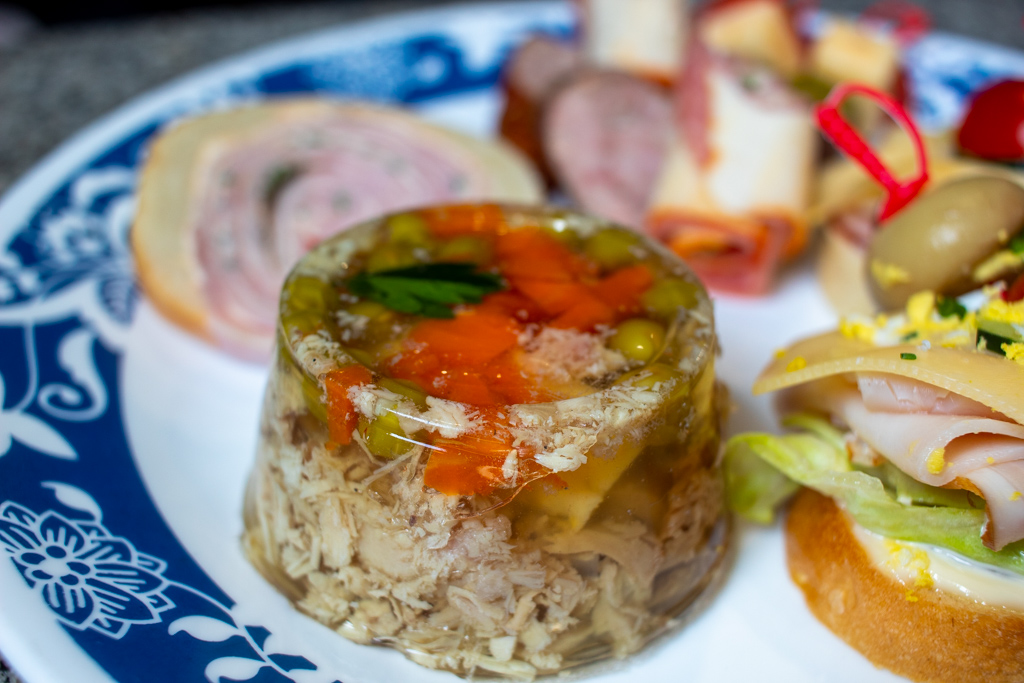
Some people–Mindy is one of them–find the concept of an aspic somewhat horrifying. I think they’re delicious, and since gelatin derives from animal bones, savory gelatins like aspics are the more traditional use of the form. These were very much like small cups of chicken soup in jello form–meat, carrots, peas, celery, parsley. Both fun to look at and fun to eat.



But it’s the kanapki we’re most interested in at the Tribunal. This open-face sandwich has lettuce, ham, and an unidentified yellow cheese stacked on a buttered thin slice of baguette, with a disk of cucumber and a halved cherry tomato stuck to it with a skewer, garnished with sprinkled egg bits and chives. The egg and chive garnish are mostly for visual interest but the mild baked ham and the nutty alpine-style cheese are a classic combination and don’t need much help. There’s a nice crunch from the lettuce and cucumber and the tomato certainly keeps things from getting too dry. If the sandwich were larger, some mustard or pickle might be a good addition but for a small, 2-3 bite open-face sandwich, this is simple and quite tasty.
And that might have been it for my exploration of Polish kanapki. However, the internet had other plans for me. A fan of the site who I’ve gotten friendly with on Instagram, Grzegorz Witek, reached out to offer his assistance in my research. Grzegorz is a Polish man living in Poland, a frequent world traveler and gourmand with a very solid command of English, and I gladly leaned heavily on his native expertise in Polish cuisine.
“Well basically,” said Grzegorz, “kanapka just means a sandwich. It’s what we have for breakfast usually, it’s not really popular to have hot food for breakfast on weekdays. You just take some bread, butter it rather thickly and put whatever you want on there. Most people would just take some ham, cheese – I guess in the us you’d use Gouda or Edam to get the best approximation of Polish ‘yellow cheese.’
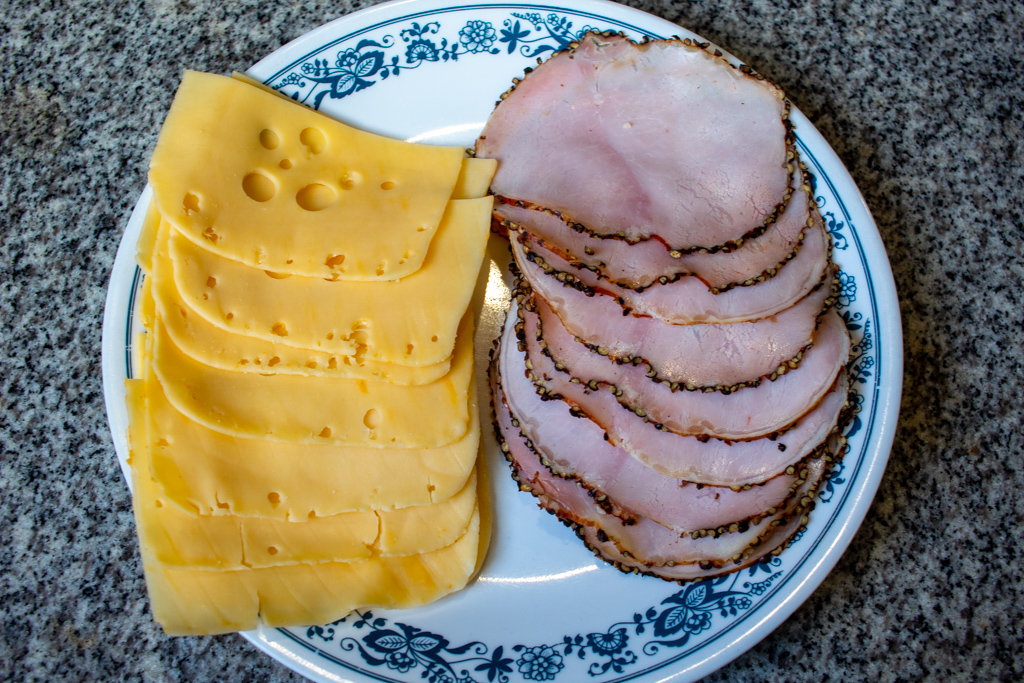
“and some vegetables like lettuce, radishes, tomatoes, cucumbers or onions. Not all of them, mind you, they are still open faced sandwiches.
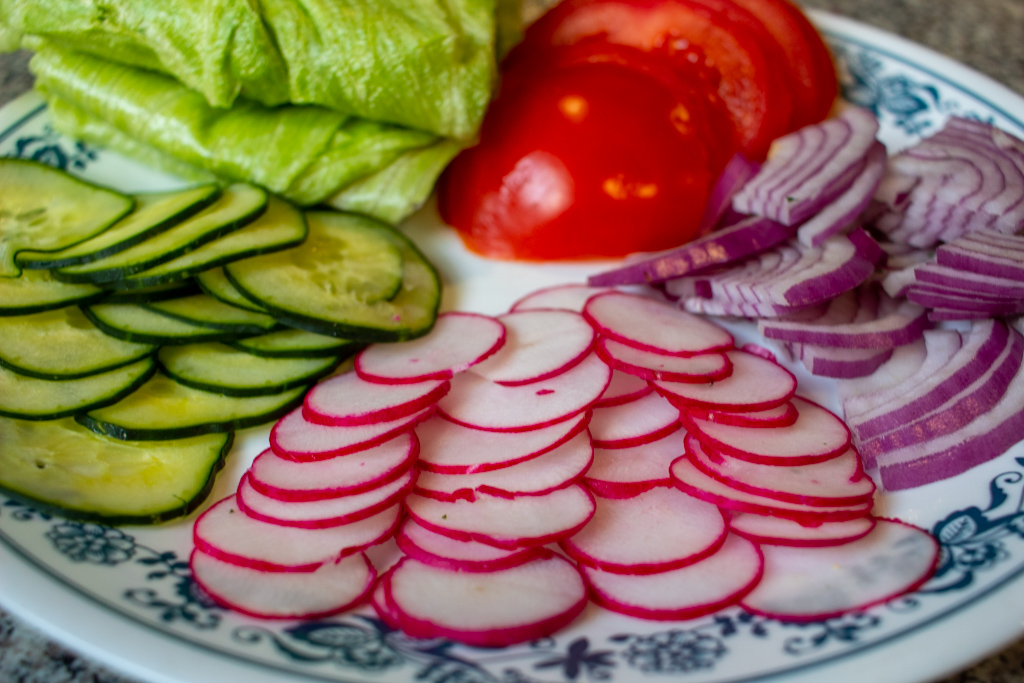
“Other options – you can make pasta jajeczna (hardboiled eggs chopped up and mixed with mayonnaise, Dijon mustard, salt and pepper).
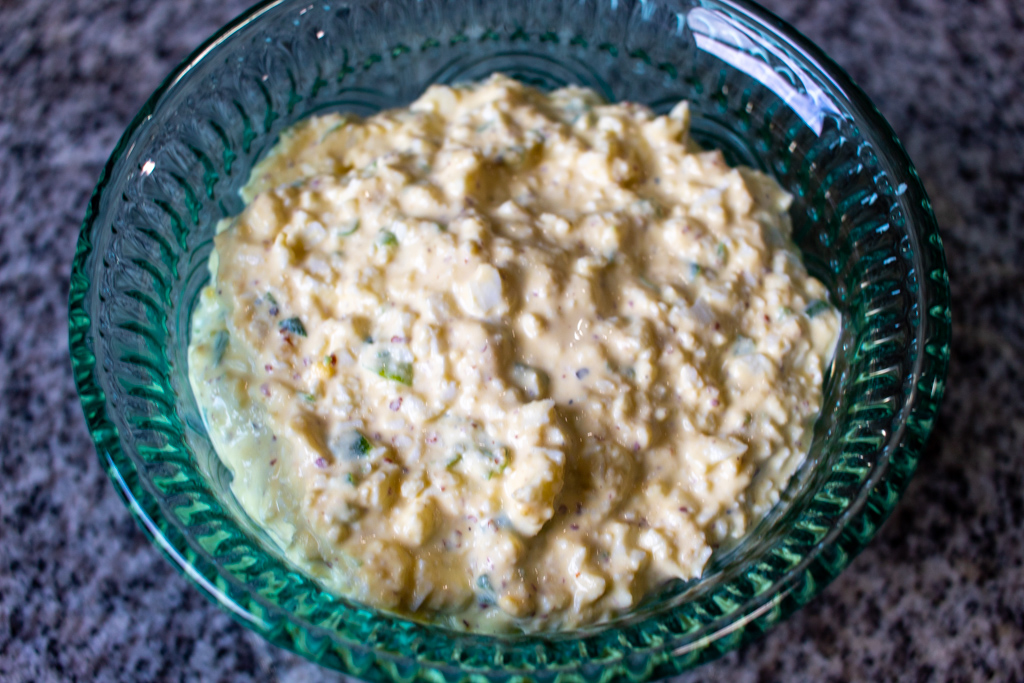
“You could make awanturka (literal translation means ‘a small argument’) which is cottage cheese (it can be called quark outside of Poland, or twaróg which is the Polish name) mixed with meat of a smoked mackerel, radishes and a bit of chives with salt and pepper
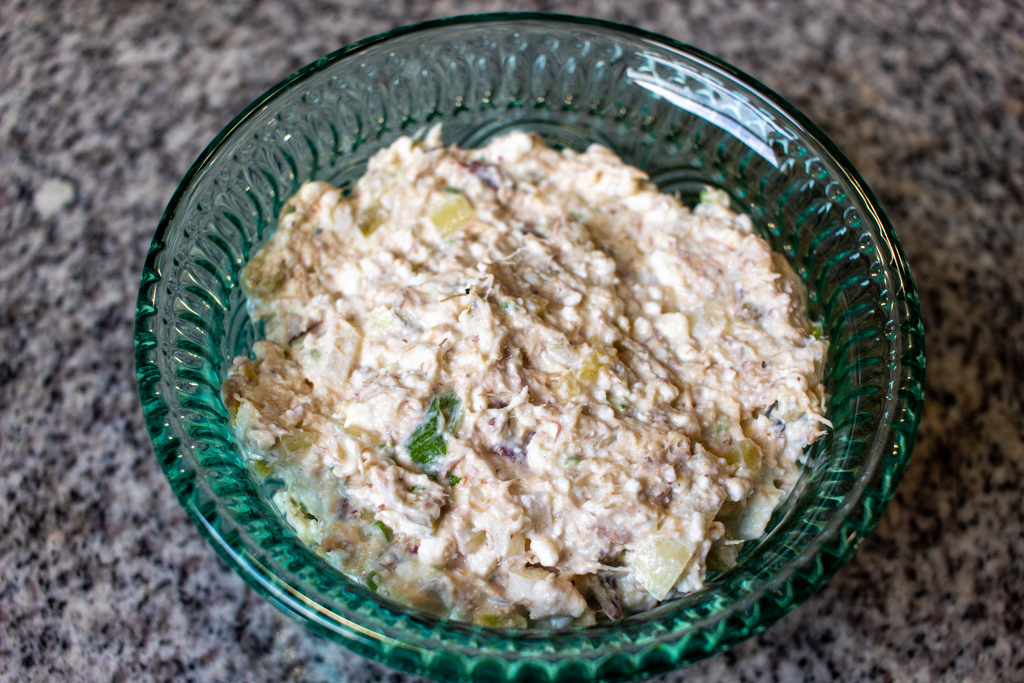
“or even a garlic spread (a very garlicky version of pimento cheese – like very very garlicky. You just mix grated cheese with mayo and double the amount of garlic you think is necessary. 10-12 per pound of cheese is not unheard of). It’s just called pasta serowo-czosnkowa.
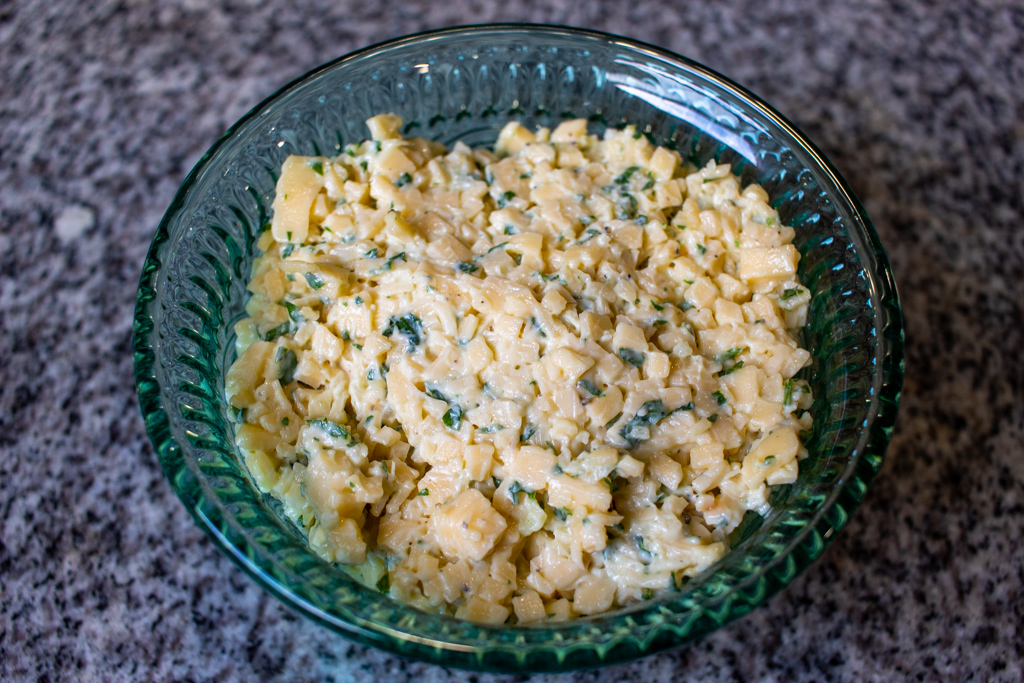
“As for bread, whole wheat or rye would be used most commonly…


“Generally kanapka is supposed to be made and eaten quickly, they are way less elaborate than oblozene chlebicky for example. What you got [from Gorka Deli as described above -Jim] was the ‘party version,’ but it’s pretty much the same as chlebicky. The homemade stuff though it’s different – a quick breakfast or a snack. I’d say that the most distinguishing features versus just an open faced ham or cheese sandwich would be either the bread or the huge variety of spreads like pasta jajeczna or awanturka. I do urge you to try the spreads, awanturka in particular – it’s my absolute favourite.”
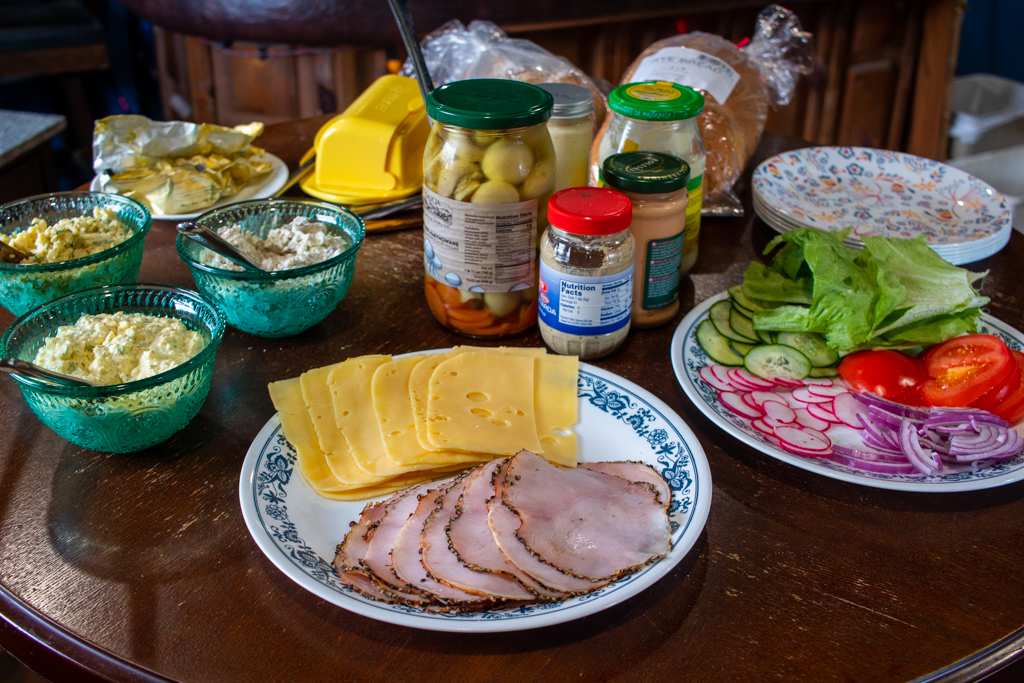
Grzegorz–it would be a tactical error of stunning proportions for me to receive such a thorough download of sandwich knowledge and not try it. Of course I made the awanturka, pasta jajeczna, and pasta serowo-czosnkowa, using the recipes I linked above (these are recipes I found and not necessarily the exact recipes Grzegorz recommended, so blame me if they’re wrong). We had Mindy’s parents in town recently, and on a Sunday morning before they departed to make their way back to the Pacific Northwest, I set out a Kanapki spread for breakfast–two kinds of Polish bread, a sourdough and a rye, along with butter; a pepper-crusted ham and Królewski, a distinctive but not overpowering Alpine-style cheese; the three homemade Polish sandwich spreads; lettuce, tomato, red onion, sliced radish, and cucumber; pickled mushrooms; and a set of Polish condiments including specific Polish brands of mustard (Kamis) and mayonnaise (Kielecki) recommended by Grzegorz.
Building a kanapka–or several kanapki–is a simple process. Starting with a hearty Polish bread
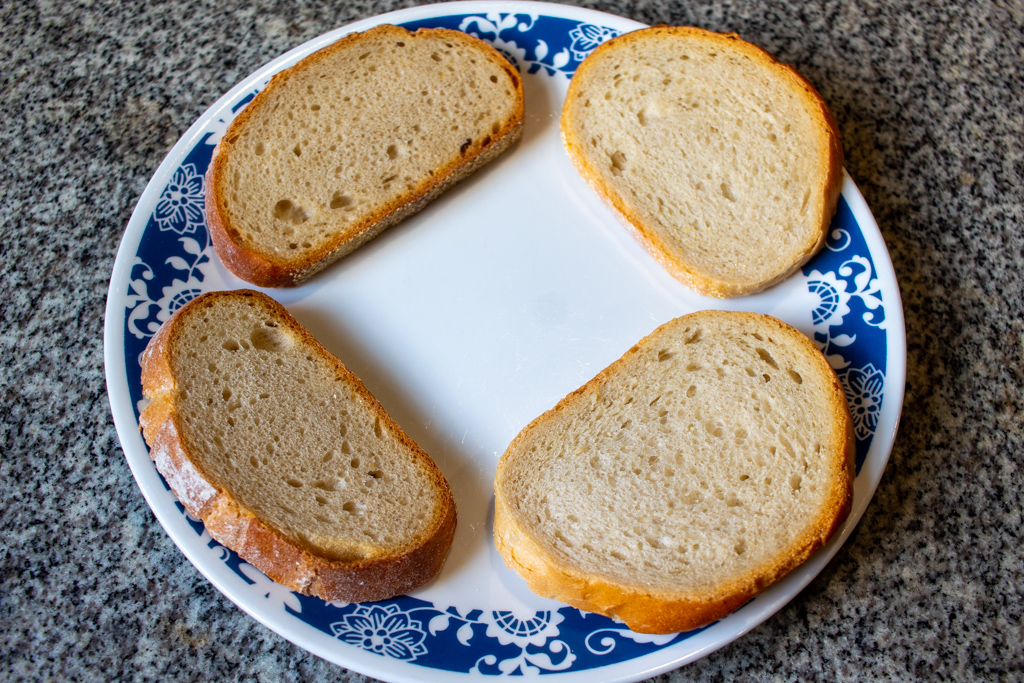
add a good thick swipe of butter

Then add a topping–it can be as simple as ham with or without cheese
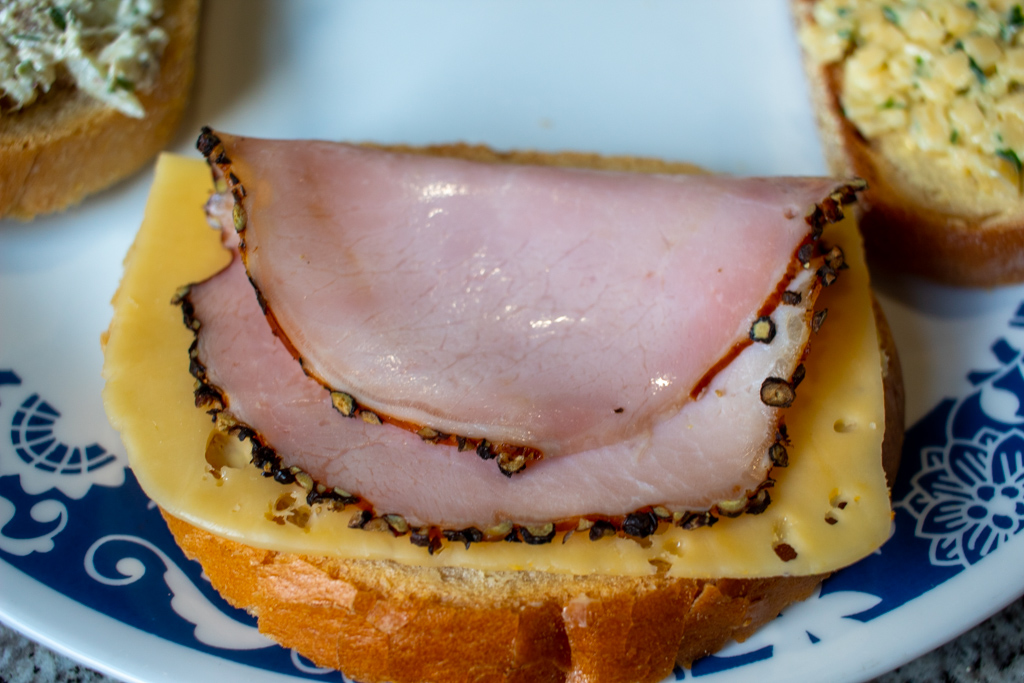
or a fairly basic egg salad
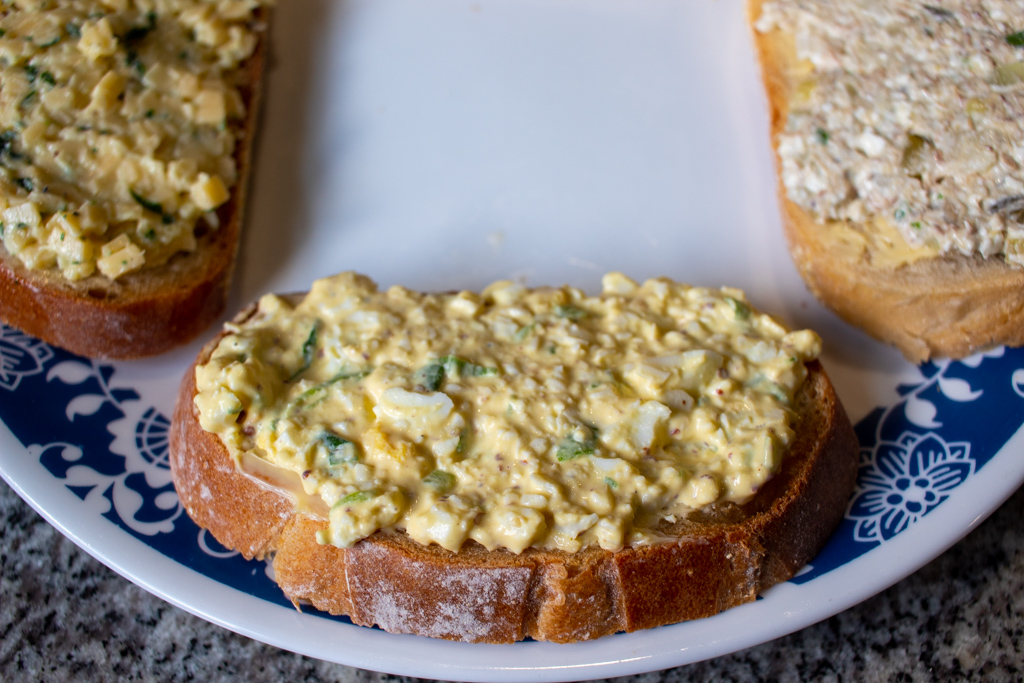
a spread of smoked mackerel with cottage cheese and onions
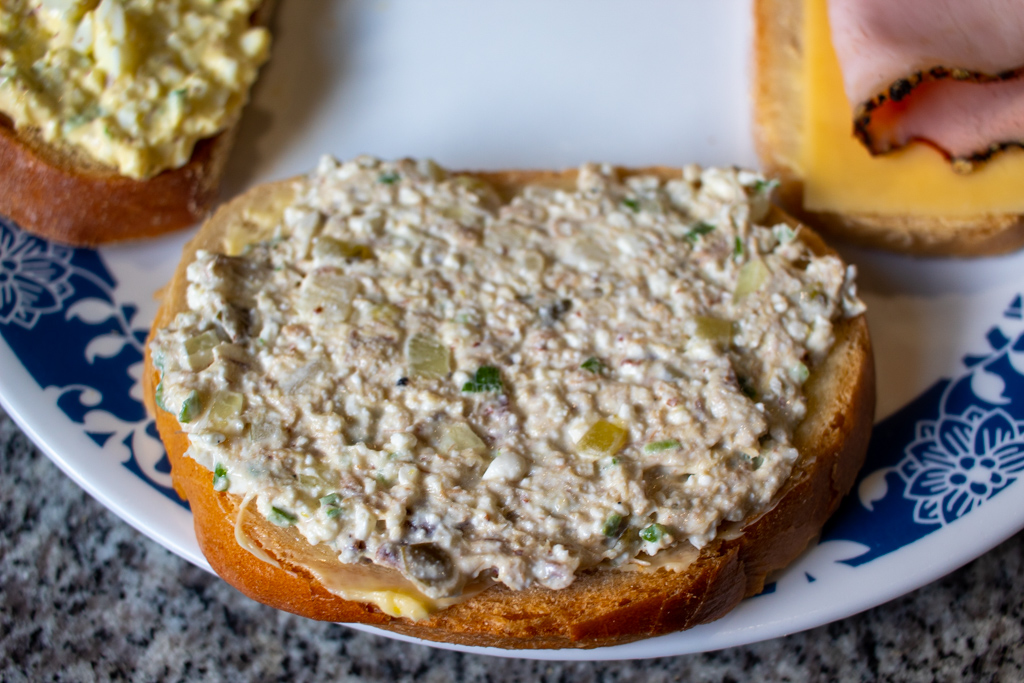
or a super garlicky cheese spread
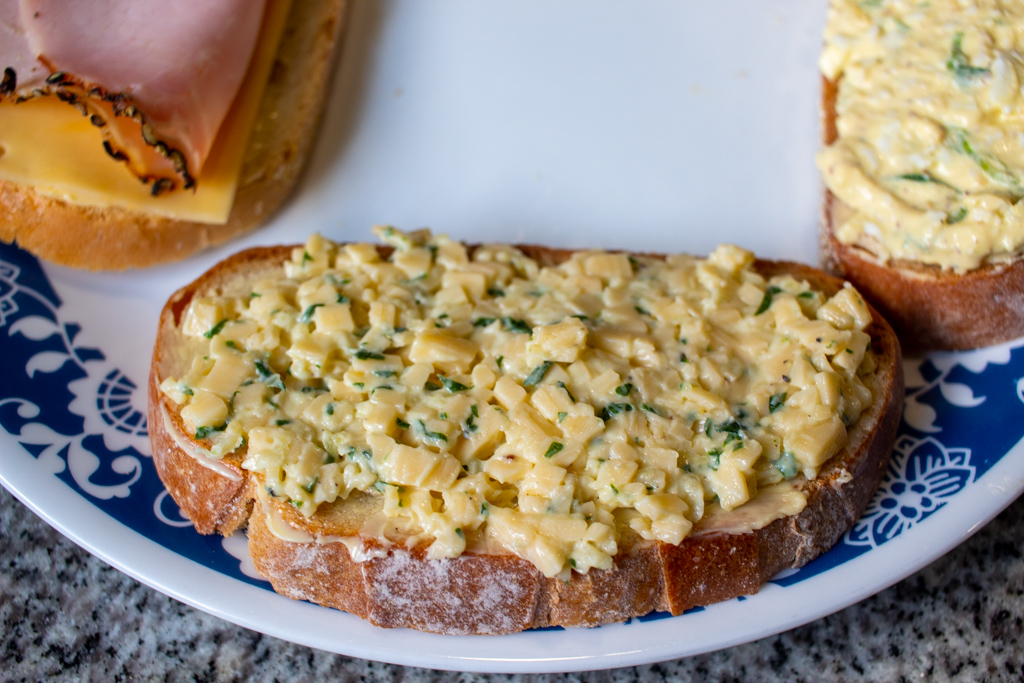
Then choose a garnish for each. For the ham and cheese, I chose a Polish “STRONG” chili pepper mustard with lettuce and onion
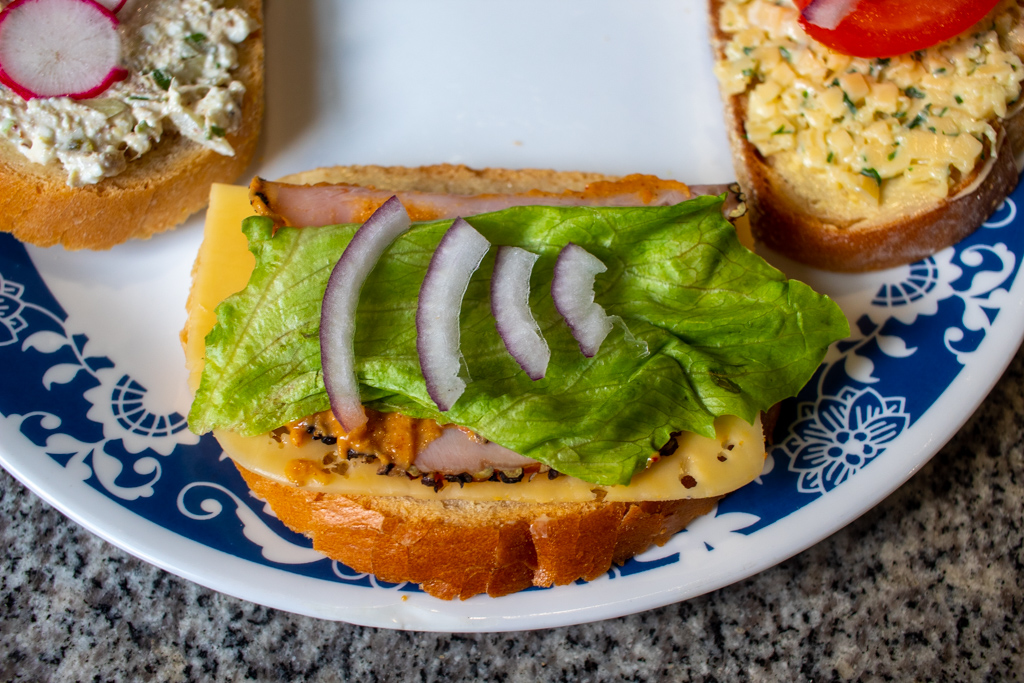
For the pasta jajencza, I went with cucumber slices
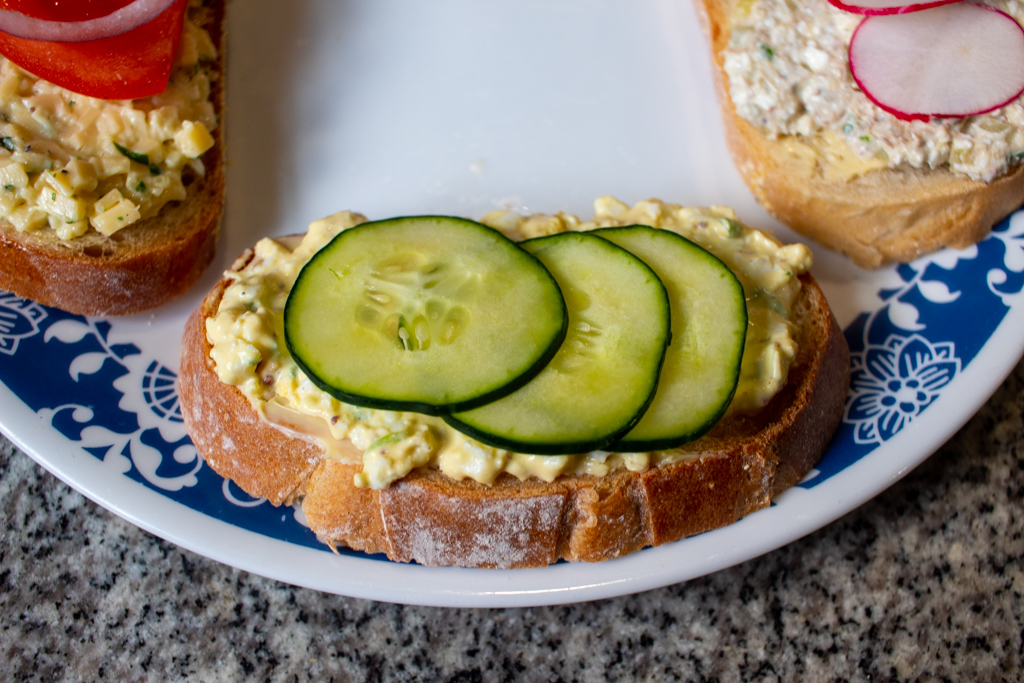
Grzegorz had mentioned radishes in connection with Awanturka–the recipe I used did not include them, so I added them as garnish
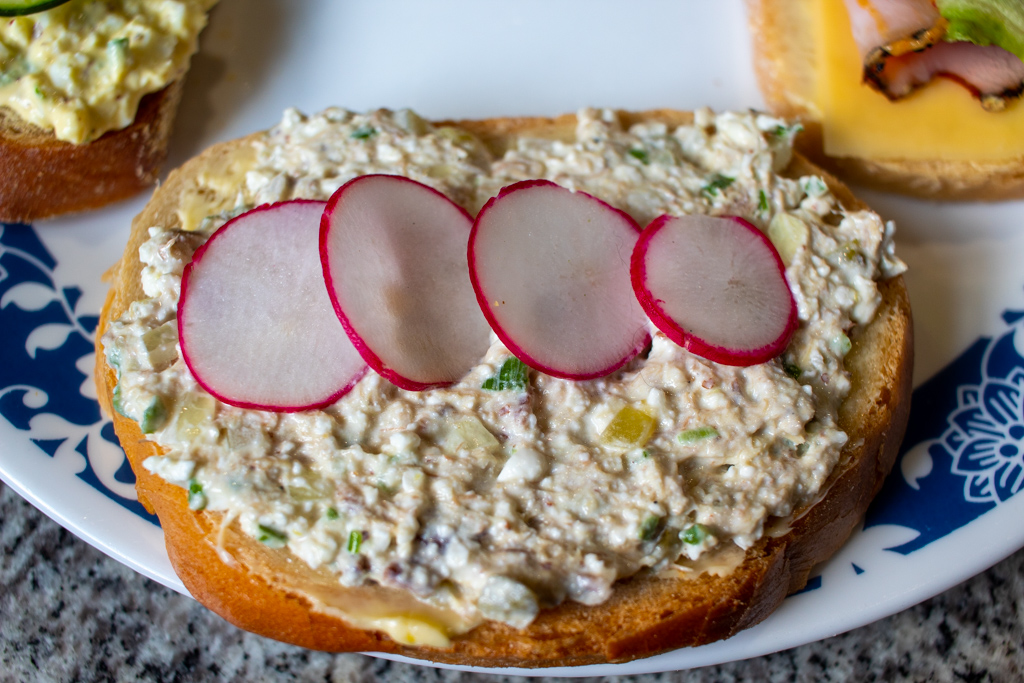
And for the pasta serowo-czosnkowa, I chose tomato and onion.
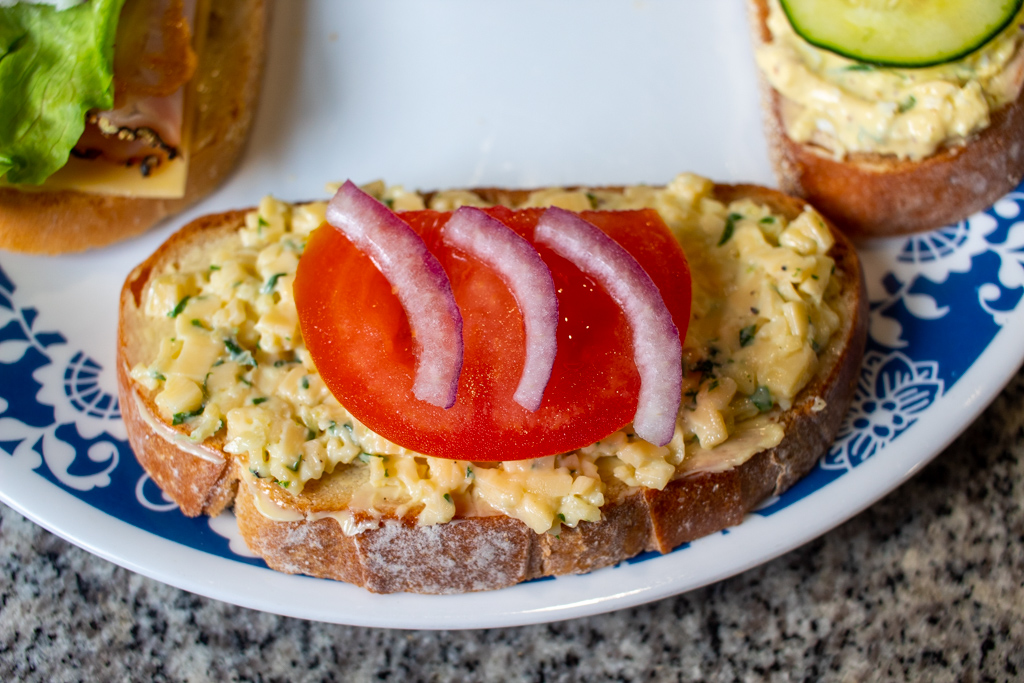
I added some pickles mushrooms to my plate and voila! Breakfast.
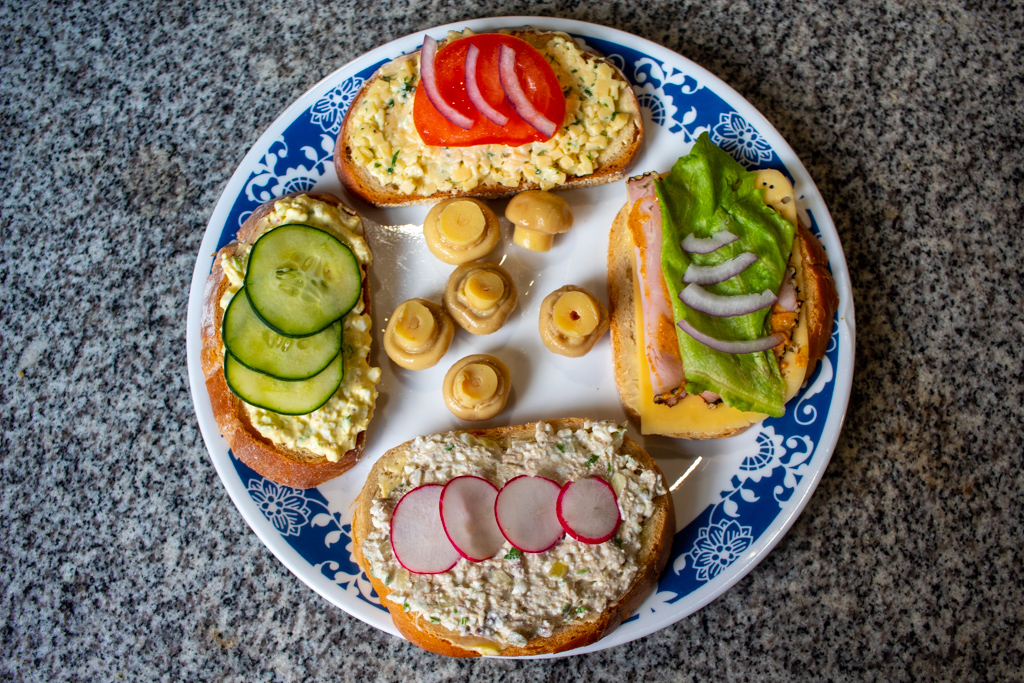
It was a great collection of sandwiches, and a nice variety all on one plate. The pasta jajeczna is simple, just eggs, mayo, mustard, and chives, very similar to the egg salad I’m used to but minced a little finer, and the crisp cucumber added a welcome freshness and textural interest. The awanturka was as good as Grzegorz promised, though next time I’d follow his advice and add diced radishes and a lot more black pepper directly into the spread. I made it with smoked mackerel per Grzegorz and it is a milder-flavored fish that would benefit from the additional flavor and texture. Ham and cheese with a spicy mustard is a classic, and lettuce and onion were a solid accompaniment to it. My favorite of all, though, was the pasta serowo-czosnkowa. This was finely minced Królewski with a lot of raw garlic and just enough tangy Polish mayonnaise to bind it together into a spread. I’d made it the night previous to let the flavors blend, and some of the hotness of the raw garlic had gone away as a result, but it was still a punch in the teeth, and rather than overwhelm the cheese, all that garlic seemed to boost its flavor. The juicy tomato was a good accompaniment for the spread but the raw onion went practically unnoticed.
It was only at this point that I realized I’d forgotten to set out the jar of Polish gherkins I’d bought, or the other spread that Grzegorz had recommended, ćwikła, a blend of minced beetroot with horseradish.
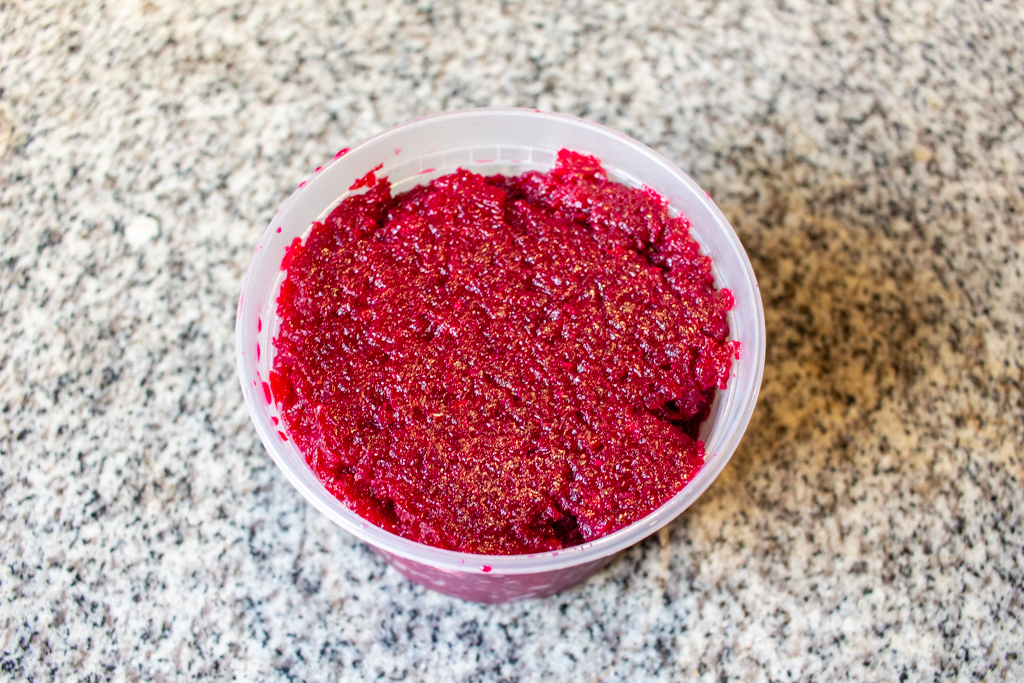
Though horseradish is quite a strong flavor, the balance of this version favored the sweet earthiness of the beets, and I wished it had more of the nose-burning heat of the horseradish. Still, it’s an excellent and surprising blend of flavors, and is great on bread with butter and minimal accompaniment.
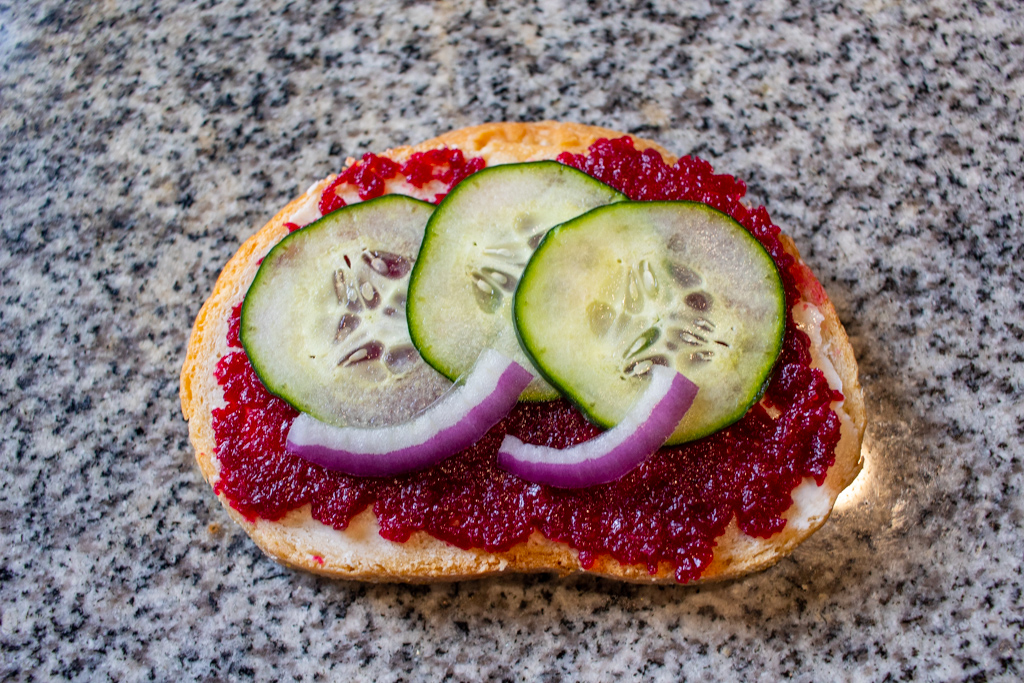
However, my eldest son Damian found the best use of it and spent much of that morning at the back table, grabbing a slice of the sourdough, spreading on some butter and that that garlicky pasta serowo-czosnkowa and then topping it with the beet/horseradish mixture. The garlic in the cheese spread helped make up for the lack of horseradish burn in the ćwikła, and the beets at least made you feel for a moment like you might be eating something healthier than a great gob of cheese and mayonnaise.
And you are. Beets are crazy good for you. For that matter, so are a lot of the ingredients you’ll find in Polish food–pickles, fish, eggs, root vegetables. I like the Polish take on open-face sandwiches; the simplicity of the formula, a main ingredient and a garnish, the lack of attention paid to trying to make this elaborate and beautiful edible art that so many of these nibbles tend to be. (Yes my sandwiches were also pretty. That’s not the point.) I’m excited about Królewski cheese, which I remember getting when we made Polish Zapiekanka but I don’t remember being this amazing. I need to get the Polish sourdough we bought at Lassak again as well. Basically I just want to eat more and more Polish food.
And I will. But for now, I’ve got 2 more sandwiches to cover this month. I’d really like to thank Grzegorz for his help with this sandwich–any value people might get out of this post is entirely due to his influence. Anybody else out there a fan of kanapki? We’d love some more suggestions for toppings! Please comment below.

I like sandwiches.
I like a lot of other things too but sandwiches are pretty great




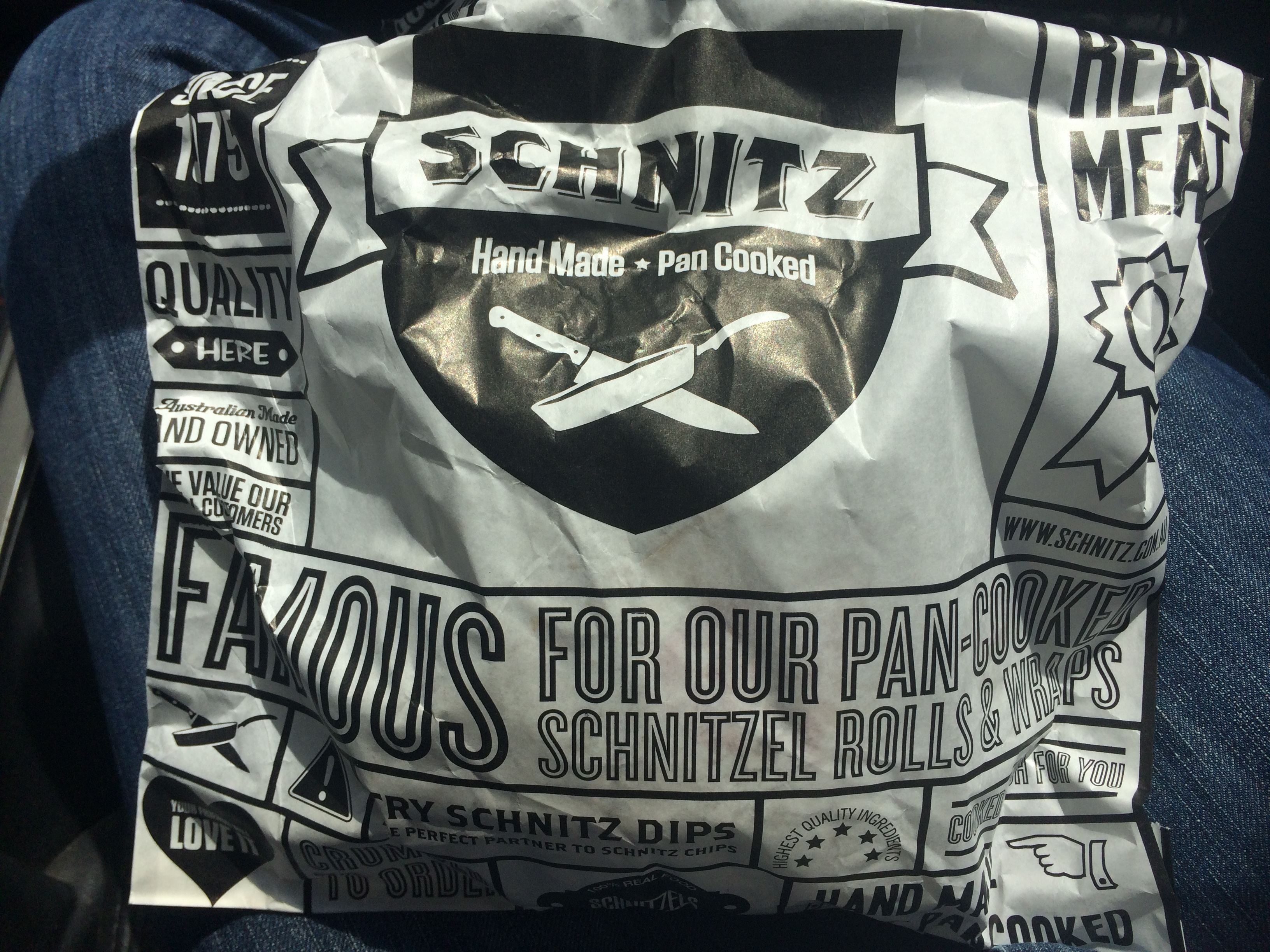






Recent Comments